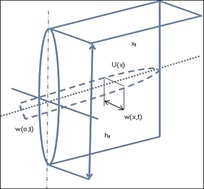The effect of operating fracturing parameters on fracture conductivity and proppant mass requirement for tight Oligocene reservoir
Abstract
The authors used the experimental central composite design (CCD) and optimum response surface methodology (RSM) to investigate the effect of four operating fracturing parameters on fracture conductivity during hydraulic injection in the Oligocene reservoir. By using the RSM method, the maximised fracture conductivity has been determined according to four optimum factors including leak-off coefficient, proppant concentration, injection time, and injection rate. The correlation between the responses of fracture conductivity and four parameters has been presented in the research with the confident coefficient factor of R square of 0.995 and R square adjust of 0.990. The results showed that the maximum fracture conductivity was 1,300md.ft with optimal leak-off coefficient of 0.0031ft/min0.5, injection rate of 40bpm, injection time of 96 minutes, and proppant concentration of 10ppg.
References
2. BJ. Hydraulic fracturing post job report for wells. 2010.
3. BJ-PVDrilling JV Company Ltd. Fracturing report summary. 2011. 4. M.King Hubbert, David G.Willis. Mechanics of hydraulic fracturing. Society of Petroleum Egineers. 1957; 210: p. 153 - 168.
5. W.R.Matthews, J.Kelly. How to predict formation pressure and fracture gradient from electric and sonic logs. Oil and Gas Journal. 1967.
6. E.S.Pennebaker. An engineering interpretation of seismic data. Fall Meeting of the Society of Petroleum Engineers of AIME. 29 September - 2 October, 1968.
7. Ben A.Eaton. Fracture gradient prediction and its application in oil field operations. Journal of Petroleum Technology. 1969; 21(10): p. 1353 - 1360.
8. Stan A.Christman. Offshore fracture gradients. Journal of Petroleum Technology. 1973; 25(8): p. 910 - 914.
9. L.A.MacPherson, L.N.Berry. Prediction of fracture gradients. Log Analyst. 1972.
10. J.A.Cornell. How to apply response surface methodology (2nd edition). American Society for Quality Control, Milwaukee, WI. 1990.
11. Douglas C.Montgomery. Design and analysis of experiments (5th edition). John Wiley and Sons, New York. 2001.
12. Raymond H.Myers, Douglas C.Montgomery. Response surface methodology: Process and product optimization using designed experiments (2nd
edition). John Wiley and Sons, New York . 2002.
13. Raymond H.Myers, Douglas C.Montgomery, Christine Anderson-Cook. Response surface methodology: Process and product optimization using designed experiments (3rd edition). John Wiley and Sons, New York. 2009.
14. T.K.Perkins, L.R.Kern. Width of hydraulic fractures. Journal of Petroleum Technology. 1961; 13(9): p. 937 - 949.
15. George E.P.Box, Norman Richard Draper. Empirical modelbuilding and response surfaces. Wiley, New York. 1987.
16. G.E.P Box, J.S.Hunter. Multi-factor experimental designs for exploring response surfaces. The Annals Mathematical Statistics. 1957; 28(1): p. 195 - 241.
17. George J.Klir, Ute St.Clair, Bo Yuan. Fuzzy set theory: Foundations and applications. Prentice Hall, New Jersey, USA. 1997.
18. Hans-Jürgen Zimmermann. Fuzzy set theory and its applications (2ndedition). Springer. 1991.
19. Ramandeep S.Sidhu, Sunil Khullar, Parvinder S.Sandhu, R.P.S.Bedi, Kiranbir Kaur. A subtractive clustering based approach for early prediction of fault proneness in software modules. Engineering and Technology International Journal of Computer and Systems Engineering. 2010; 4(7).
20. Petrovietnam. Fractured basement reservoir. Science and Technics Publishing House. 2008.
21. B.B.Williams. Fluid loss from hydraulically induced fractures. Journal Petroleum Technology. 1970; 22(7).
22. Bert B.Williams, John L.Gidley, Robert S.Schechter. Acidizing fundamentals. Society of Petroleum Engineers. 1979.
23. M.B.Smith. Hydraulic fracturing (2ndedition). NSI Technologies, Tulsa, Oklahoma. 1997.
24. Michael Richardson. A new and practical method for fracture design and optimisation. SPE/CERI Gas Technology Symposium, Calgary, Alberta, Canada. 3 - 5 April 2000.
25. K.G.Nolte. Determination of proppant and fluid schedules from fracturing pressure decline. SPE Production Engineering. 1986; 1(4): p. 255 - 265.
26. H.Z.Meng, K.E.Brown. Coupling of production forecasting, fracture geometry requirements and treatment scheduling in the optimum hydraulic fracture design. SPE 16435. SPE Low Permeability Reservoirs Symposium, Denver, Colorado. 18 - 19 May, 1987.
27. R.P.Nordgren. Propagation of a vertical hydraulic fracture. Society of Petroleum Engineers Journal. 1972; 12(4): p. 306 - 314.
28. Michael Economides, Ronald Oligney, Peter Valkó. Unified fracture design. Orsa Press. 2002. 29. George C.Howard, C.R.Fast. Optimum fluid
characteristics for fracture extension. Drilling and Production Practice, New York. 1 January 1957.
30. M.M.Rahman, M.K.Rahman, S.S.Rahman. Optimizing treatment parameters for enhanced hydrocarbon production by hydraulic fracturing. Journal of Canadian Petroleum Technology. 2003; 42(6): p. 38 - 46.
31. Peter Valkó, Michael J.Economides. Hydraulic fracture mechanics. John Wiley & Sons, Chichester, England. 1995.
32. B.R.Meyer, R.H.Jacot. Impact of stress-dependent Young’s moduli on hydraulic fracture modeling. The 38th U.S. Symposium on Rock Mechanics, Washington, DC . 7 - 10 July, 2001.
33. Lucas W.Bazan, Sam D.Larkin, R.Henry Jacot, Bruce R.Meyer. Modeling of simultaneous proppant fracture treatments in the fruitland coal and pictured cliffs formations in the San Juan basin. SPE Eastern Regional Meeting, Lexington, Kentucky. 23 - 26 October, 2002 .

1. The Author assigns all copyright in and to the article (the Work) to the Petrovietnam Journal, including the right to publish, republish, transmit, sell and distribute the Work in whole or in part in electronic and print editions of the Journal, in all media of expression now known or later developed.
2. By this assignment of copyright to the Petrovietnam Journal, reproduction, posting, transmission, distribution or other use of the Work in whole or in part in any medium by the Author requires a full citation to the Journal, suitable in form and content as follows: title of article, authors’ names, journal title, volume, issue, year, copyright owner as specified in the Journal, DOI number. Links to the final article published on the website of the Journal are encouraged.




